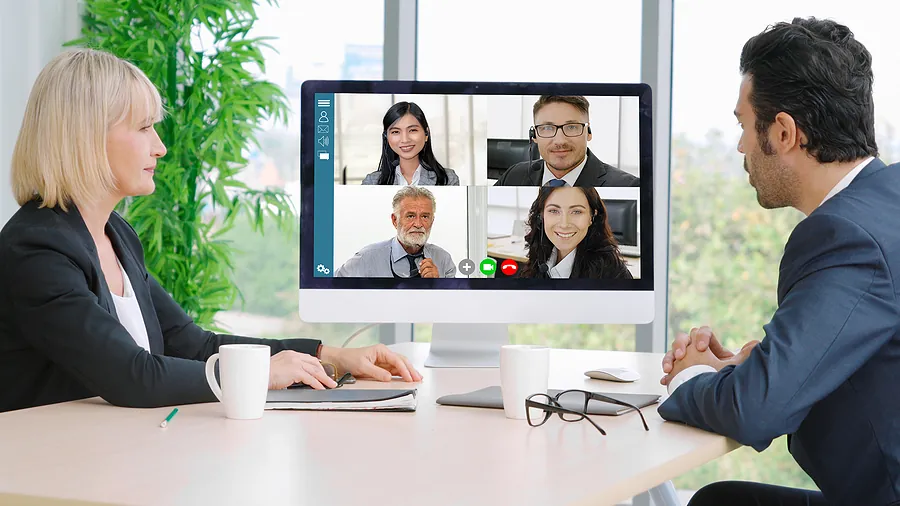How to Sell Virtually

Conducting business virtually is nothing new, but it got quite the push in 2020. Nowadays, everyone is meeting online. For example, in April, Microsoft reported a new daily record of 2.7 billion meeting minutes in one day, up from 900 million only a couple of weeks prior. Learning how to sell virtually has changed from a nice-to-have skill to a must-have requirement as in-person meetings are largely a thing of the past.
The question then is, what are virtual sales, and how do I reach the same level of success as before? To achieve the same connection, engagement, and results as you would with an in-person meeting, we’re sharing 10 key tips and tactics to use in your virtual sales process, sales strategy, and sales training.
#1: Choose the Best Video Conferencing Tool
Telecommunications has become one of the top industries of growth over the past several years. It should come as no surprise that companies are making huge investments in creating and improving their systems to meet the surge in demand for video conferencing tools.
Microsoft Teams, Google Meet, and Zoom are some of the game’s top players, but these are likely to face increased competition soon. To choose the best video conferencing tool for your team’s virtual sales meetings, you need to consider:
- How easy is it to use?
- Does it require downloading a program or any special requirements beyond an internet connection?
- How reliable is the infrastructure?
- Does it sync up with other systems currently in place?
Once you’ve performed your due diligence and chosen a platform, ensure every person in your organization uses the same tool and has command of its various features. Screen sharing, hosting capabilities, and chat functions are a few that are useful during demos and presentations. Prioritize what your team needs most to perform at its best.
#2: Follow an Established Sales Process
Before you can innovate or improve a process, a team must be aligned and find a common ground. This is critical for any sales organization and managing sales teams remotely. A typical sales process includes prospecting, qualifying, presenting, and closing the deal. It also involves account management and client retention. Establish which type of communication is best for each stage of the sales cycle and what changes you need to adapt to virtual selling.
For example, suppose demos are the main component of your sales process. In that case, in-person events or meetings aren’t currently doable, which means you’ll need to translate that information into online demos. Set an agenda that offers enough time to adequately showcase the product or service, answer client questions, and map out the next steps in one video call.
Also, test equipment ahead of time to ensure a smooth delivery. Few things ruin the momentum of a presentation faster than a faulty connection or pixelated screen. Establishing your virtual sales process serves as a foundation to then improve upon and personalize based on feedback.
#3: Engage Your Audience
Learning how to sell virtually requires making the most of your time by engaging your audience in the sales conversation. This is achieved through visual aids, clear messaging, and interactive discussions. You’ll want to schedule enough time to share the information necessary to make a decision but not so long that your audience loses interest.
For a more extended meeting or event, schedule regular breaks and prompts to keep people engaged with the process and ask questions about the material. Keep in mind, when presenting to more than one decision-maker at a time, the Q&A portion of the conversation is invaluable as each person will retain the information differently and have specific questions pertaining to how they can apply it to their own team.
#4: Keep Sales Highly Educational for Prospects
During the prospecting phase, you want to show how your product or service solves a problem. Whether you’re prospecting by email, through LinkedIn, or another method, keep the information straightforward and educational. Discuss:
- What your product/service does
- Who it’s meant to help
- Why it’s a unique or a favorable resolution to similar products/services
- How it’s going to improve a person’s life
Hone in on data points like case studies, ROI percentages, and other metrics that present what you’re selling in a positive light and illustrate credibility and trust you’ve already built with other clients.
#5: Use Storytelling in Your Sales Approach
Another tactic when selling virtual is using storytelling to share information on a personable level. While you want to be educational with supporting data to tell the story, it’s important to provide context. Data on its own is less impressive than when you attach it to a scenario that makes it feel personalized and makes the experience more memorable.
One of the key factors of being a successful salesperson is creating an authentic connection. Prior to presenting, perform audience research that’ll speak directly to their needs and goals. Even with the most impressive numbers, if they don’t make a connection to how what you’re selling can specifically solve their problem(s), it doesn’t work.
#6: Be an Active Listener
Being an active listener means generating interaction while remaining aware of the other people in the virtual room. Learning how to sell virtually includes watching for nonverbal language cues that can be easily interpreted in person. After presenting a section of information, pause, and give your audience a chance to respond.
If you see someone is distracted or may seem confused about a certain point, slow down and make sure they’re retaining the information being presented. It’s less about getting through as much information at once and more about making sure that it’s making the desired impact. Additionally, when fielding questions, repeat back part of the question, avoid general or vague answers or advice, and provide clear examples to emphasize your point.
#7: Send Follow-Ups
Follow-ups ensure everyone is one the same page. After a conference call or video chat, send a brief summary of the meeting, and highlight the next steps. In addition to thanking them for their time, offer an added value, such as a link to an online resource that was referenced or marketing materials that may guide them toward a favorable outcome. This gives you both a record of what expectations look like going forward to eliminate miscommunication and keep the process moving forward.
#8: Track Metrics
Gauge your performance by tracking metrics. Set individual and team data points to ensure you’re progressing toward your goals, identifying areas for improvement, and preparing for future growth and market changes. A few KPIs you can add to your regular reports are:
- Lead response time
- Closing rate
- Average revenue of closed deals
- Number of new prospects, qualified prospects, and set appointments
Establish set figures and timelines to gauge progress and make changes along the way. Using metrics to guide your selling style will also help you recognize slow seasons in the industry, changes in consumer behavior, and other information that can shape your selling efforts from quarter to quarter. For example, if Q4 is notoriously a slower selling season, what actions will you put into place to frontload efforts at the beginning of the year?
#9: Be Flexible
Meet clients where they are as much as possible. This means you may have to adapt your communication style to what clients prefer. Some appreciate email for follow-ups and information sharing, while others favor a weekly check-in call instead of being bogged down by their inbox.
Another thing to keep in mind with everyone working from home is that people are juggling responsibilities in ways that may change at a moment’s notice. Make it easy for prospects and clients to schedule, cancel, or reschedule appointments with you through an online calendar. This can streamline the process on both ends instead of playing phone tag or waiting for email replies to have a meeting.
#10: Adapt and Refine Your Method
If 2020 has taught us anything, it’s what’s working now may not work in the future. In the past, direct calling was the number one way to achieve sales, the more people called, the better chance at getting new business. This evolved into cold emails and gaining LinkedIn referrals. Now people expect a personalized approach.
While establishing a set virtual sales process is crucial, continually engage your clients and ask for feedback, either one-to-one, through surveys, or by monitoring metrics like email open rates or social media engagement shared by other teams in your organization. This can help drive your process and meet people where they are currently.
The changing landscape of technology also makes a difference in your approach. Track metrics and watch for significant changes or noticeable trends. Then, put context to the numbers and understand the “why” of any shifts so you can refine your method accordingly.
Learning how to sell virtually requires knowing your platform, technology, audience, strengths, and weaknesses. Translating your in-person skills to make the same impact online takes time and training. As there are continuing shifts regarding best practices and new methods, the ability to adapt with confidence will allow you to maintain success even as you sell changes.
Source:
https://www.microsoft.com/en-us/microsoft-365/blog/2020/04/09/remote-work-trend-report-meetings/
Comments are closed.

- Account Planning (11)
- Awards (49)
- Client Testimonial (37)
- Personal Branding (19)
- Podcast (11)
- Research (70)
- Sales Career Development (87)
- Sales Coaching (156)
- Sales Consulting (137)
- Sales Culture (170)
- Sales Enablement (354)
- Sales Leadership (109)
- Sales Management (248)
- Sales Negotiation (16)
- Sales Prospecting (125)
- Sales Role-Playing (18)
- Sales Training (235)
- Selling Strategies (263)
- Soft Skills (70)
- Talent Management (94)
- Trusted Advisor (27)
- Virtual Selling (49)
- Webinar (9)



























Liked the concept of educating the new client during your first presentation, great idea so they want to come back for more, what do you have to teach that makes it worth spending time. I think that this will translates into sign-ups and future sales. Thanks Alan
Thank you Alan!